Secondary Flow and Endwall Optimization of a Transonic Turbine
Abstract
:1. Introduction
2. Numerical Method
2.1. Transonic Turbine Test Case
2.2. Numerical Solver
2.3. Boundary Conditions
2.4. Grid Topology
3. Optimization Framework
3.1. Endwall Profile Design Method and Design Space
3.2. Objective Functions (Multi-Objective Problem Formulation)
4. Results and Analysis
4.1. Optimization Results
4.2. Optimization of the Stator Hub
4.3. Optimization of the Rotor Hub
4.4. Cumulative Effect of the Optimized Stator and Optimized Rotor
4.5. Part Load Performance
4.6. Desing Confirmation through Unsteady Simulation
5. Conclusions
- The optimization of the stator hub resulted in an increase in efficiency by 0.27%. The objective function was formulated based on the efficiency, mass flow rate and the coefficient of secondary kinetic energy. The mass flow rate was effectively controlled within the acceptable limit. The coefficient of the secondary kinetic energy was reduced by up to 4.92%. The radial distribution of the efficiency confirmed the performance improvement by up to 60%, while that of CSKE was convincing near the hub, but dramatic near the midspan region. The shockwave interaction with the suction surface was moved further downstream towards the trailing edge, and the flow separation was removed. The strength of the fully developed passage vortex in the stator was reduced by 32%, quantified in terms of the streamwise vorticity.
- The optimization of the rotor hub was also formulated based on the three objectives. The degree of the reaction was included in the objective function in place of CSKE. The efficiency was increased by 0.25%, while the mass flow rate remained constant. The radial distribution of the degree of reaction showed a good agreement with the performance improvement. The contours of the entropy, the streamwise vorticity and the normalized helicity at the exit of the rotor reflected a decrease in the strength of vortices. The flow separation line on the suction surface of the rotor which was emanating from the hub and running towards the mid-span was wiped out due to contouring. This also indicated the delay in the interaction of the pressure and suction side legs of the passage vortex.
Author Contributions
Funding
Acknowledgments
Conflicts of Interest
Nomenclature
| P | Pressure |
| t | Time |
| T | Temperature |
| T | Rotor blade passing period |
| V | Absolute velocity |
| y+ | Non-dimensional wall distance |
| Abbreviations | |
| AEW | Axisymmetric Endwall |
| BPNN | Back Propagation Neural Network |
| CFD | Computational Fluid Dynamics |
| Cum | Cumulative |
| LE | Leading Edge |
| NEW | Non-Axisymmetric Endwall |
| NSGA-II | Non-Dominated Sorting Genetic Algorithm II |
| Opt_S | Optimization of the stator hub |
| Opt_R | Optimization of the rotor hub |
| PS | Pressure Side |
| RANS | Reynolds-Average Navier-Stokes |
| SS | Suction Side |
| TE | Trailing Edge |
| URANS | Unsteady Reynolds-Average Navier-Stokes |
| Greek Symbols | |
| σ | Mass-averaged flow angle in both pitchwise and spanwise direction |
| γ | The ratio of Specific Heats |
| ρ | Density |
| Subscripts | |
| 0 | Stator Inlet |
| 1 | Stator/Rotor Interface |
| 2 | Rotor Outlet |
| R | Radial |
| sec | Secondary |
| t | Total |
| ta | tangential |
| z | Axial |
References
- Bradshaw, P. Turbulence modeling with application to turbomachinery. Prog. Aerospace. Sci. 1996, 32, 575–624. [Google Scholar] [CrossRef]
- Denton, J.D. The 1993 IGTI Scholar Lecture: Loss Mechanisms in Turbomachines. J. Turbomach. 1993, 115, 621–656. [Google Scholar] [CrossRef]
- Langston, L.S. Secondary Flows in Axial Turbines-A Review. Ann. N. Y. Acad. Sci. 2010, 934, 11–26. [Google Scholar] [CrossRef] [PubMed]
- Scheugenpflug, H.; Fottner, L. Performance Improvements of Compressor Cascades by Controlling the Profile and Sidewall Boundary Layers. J. Turbomach. 1992, 114, 477. [Google Scholar] [CrossRef]
- Rose, M.G. Non-axisymmetric endwall profiling in the HP NGV’s of an axial flow gas turbine. In Proceedings of the ASME 1994 International Gas Turbine and Aeroengine Congress and Exposition, The Hague, The Netherlands, 13–16 June 1994; American Society of Mechanical Engineers: New York, NY, USA, 1994. [Google Scholar]
- Hartland, J.; Gregory-Smith, D.; Rose, M. Non-axisymmetric endwall profiling in a turbine rotor blade. In Proceedings of the ASME 1998 International Gas Turbine and Aeroengine Congress and Exhibition, Stockholm, Sweden, 2–5 June 1998; American Society of Mechanical Engineers: New York, NY, USA, 1998. [Google Scholar]
- Harvey, N.W.; Rose, M.G.; Taylor, M.D.; Shahpar, S.; Hartland, J.; Gregory-Smith, D.G. Nonaxisymmetric turbine end wall design: Part I—Three-dimensional linear design system. J. Turbomach. 2000, 122, 278–285. [Google Scholar] [CrossRef]
- Moore, J.G. Calculation of 3-D flow without numerical mixing. In AGARDS 3D Computation Tech. Applied to Internal Flows in Propulsion Systems; NASA: Washington, DC, USA, 1985; pp. 8.1–8.14. [Google Scholar]
- Brennan, G.; Harvey, N.W.; Rose, M.G.; Fomison, N.; Taylor, M.D. Improving the Efficiency of the Trent 500-HP Turbine Using Nonaxisymmetric End Walls—Part I: Turbine Design. J. Turbomach. 2003, 125, 497–504. [Google Scholar] [CrossRef]
- Harvey, N.; Brennan, G.; Newman, D.; Rose, M. Improving turbine efficiency using non-axisymmetric end walls: Validation in the multi-row environment and with low aspect ratio blading. In Proceedings of the ASME Turbo Expo 2002: Power for Land, Sea, and Air, Amsterdam, The Netherlands, 3–6 June 2002; American Society of Mechanical Engineers: New York, NY, USA, 2002; pp. 119–126. [Google Scholar]
- Poehler, T.; Niewoehner, J.; Jeschke, P.; Guendogdu, Y. Investigation of Nonaxisymmetric Endwall Contouring and Three-Dimensional Airfoil Design in a 1.5-Stage Axial Turbine—Part I: Design and Novel Numerical Analysis Method. J. Turbomach. 2015, 137, 081009–081009-11. [Google Scholar] [CrossRef]
- Tang, H.; Liu, S.; Luo, H. Design optimization of profiled endwall in a high work turbine. In Proceedings of the ASME Turbo Expo 2014: Turbine Technical Conference and Exposition, Düsseldorf, Germany, 16–20 June 2014; American Society of Mechanical Engineers: New York, NY, USA, 2014. [Google Scholar]
- Song, L.; Guo, Z.; Li, J.; Feng, Z. Optimization and Knowledge Discovery of a Three-Dimensional Parameterized Vane with Nonaxisymmetric Endwall. J. Propuls. Power 2017, 34, 234–246. [Google Scholar] [CrossRef]
- Obaida, H.M.; Rona, A.; Gostelow, J.P. Loss Reduction in a 1.5 Stage Axial Turbine by Computer-Driven Stator Hub Contouring. J. Turbomach. 2019, 141, 061009. [Google Scholar] [CrossRef]
- Rehman, A.; Liu, B. Numerical Investigation and Non-Axisymmetric Endwall Profiling of a Turbine Stage. J. Therm. Sci. 2019, 28, 811–825. [Google Scholar] [CrossRef]
- Kim, I.; Kim, J.; Cho, J.; Kang, Y.-S. Non-axisymmetric endwall profile optimization of a high-pressure transonic turbine using approximation model. In Proceedings of the ASME Turbo Expo 2016: Turbomachinery Technical Conference and Exposition, Seoul, Korea, 13–17 June 2016; American Society of Mechanical Engineers: New York, NY, USA, 2016. [Google Scholar]
- Göttlich, E.; Neumayer, F.; Woisetschläger, J.; Sanz, W.; Heitmeir, F. Investigation of Stator-Rotor Interaction in a Transonic Turbine Stage Using Laser Doppler Velocimetry and Pneumatic Probes. J. Turbomach. 2004, 126, 297–305. [Google Scholar] [CrossRef]
- Menter, F.R. Two-equation eddy-viscosity turbulence models for engineering applications. AIAA J. 1994, 32, 1598–1605. [Google Scholar] [CrossRef] [Green Version]
- Giles, M.B. Stator/rotor interaction in a transonic turbine. J. Propuls. Power 1990, 6, 621–627. [Google Scholar] [CrossRef]
- Giles, M. UNSFLO: A Numerical Method for Unsteady Inviscid Flow in Turbomachinery; Gas Turbine Laboratory, Massachusetts Institute of Technology: Cambridge, MA, USA, 1988. [Google Scholar]
- Hawes, C.; Williams, R.; Ingram, G. Investigating endwall-blade fillet radius variation to reduce secondary flow losses. In Proceedings of the 11th European Conference on Turbomachinery: Fluid Dynamics and Thermodynamics, Madrid, Spain, 23–25 March 2015; European Turbomachinery Society: Florence, Italy, 2015. [Google Scholar]
- Ananthakrishnan, K.; Govardhan, M. Influence of fillet shapes on secondary flow field in a transonic axial flow turbine stage. Aerosp. Sci. Technol. 2018, 82, 425–437. [Google Scholar] [CrossRef]
- Pierret, S.; Van den Braembussche, R.A. Turbomachinery Blade Design Using a Navier–Stokes Solver and Artificial Neural Network. J. Turbomach. 1999, 121, 326–332. [Google Scholar] [CrossRef]
- Demeulenaere, A.; Ligout, A.; Hirsch, C. Application of multipoint optimization to the design of turbomachinery blades. In Proceedings of the ASME Turbo Expo 2004: Power for Land, Sea, and Air, Vienna, Austria, 14–17 June 2004; American Society of Mechanical Engineers: New York, NY, USA, 2004; pp. 1481–1489. [Google Scholar]
- Deb, K.; Pratap, A.; Agarwal, S.; Meyarivan, T. A fast and elitist multiobjective genetic algorithm: NSGA-II. IEEE T. Evolut. Comput. 2002, 6, 182–197. [Google Scholar] [CrossRef] [Green Version]
- Wang, X.; Hirsch, C.; Kang, S.; Lacor, C. Multi-objective optimization of turbomachinery using improved NSGA-II and approximation model. Comput. Method Appl. Mech. Eng. 2011, 200, 883–895. [Google Scholar] [CrossRef]
- Vinuesa, R.; Schlatter, P.; Nagib, H. Secondary flow in turbulent ducts with increasing aspect ratio. Phys. Rev. Fluids 2018, 3, 054606. [Google Scholar] [CrossRef]
- Ingram, G.L. Endwall Profiling for the Reduction of Secondary Flow in Turbines. PhD Thesis, University of Durham, Durham, England, 2003. [Google Scholar]
- Snedden, G.; Dunn, D.; Ingram, G. On-and off-design performance of a model rotating turbine with non-axisymmetric endwall contouring and a comparison to cascade data. Aeronat. J. 2018, 122, 646–665. [Google Scholar] [CrossRef]
- Zhu, C.; Wang, T.; Wu, J. Numerical Investigation of Passive Vortex Generators on a Wind Turbine Airfoil Undergoing Pitch Oscillations. Energies 2019, 12, 654. [Google Scholar] [CrossRef]
- Zorić, T. Experimental Investigation of Secondary Flows in a Family of Three Highly Loaded Low-Pressure Turbine Cascades; Carleton University: Ottawa, ON, Canada, 2006. [Google Scholar]
- Degani, D.; Seginer, A.; Levy, Y. Graphical visualization of vortical flows by means of helicity. AIAA J. 2012, 28, 1347–1352. [Google Scholar] [CrossRef]
- Rai, M.M. Three-dimensional Navier-Stokes simulations of turbine rotor-stator interaction. Part I-Methodology. J. Propuls. Power 1989, 5, 305–311. [Google Scholar] [CrossRef]
- NUMECA International. FINETM/Turbo 10.1—User Manual. NUMECA International: Brussels, Belgium, 2015. [Google Scholar]
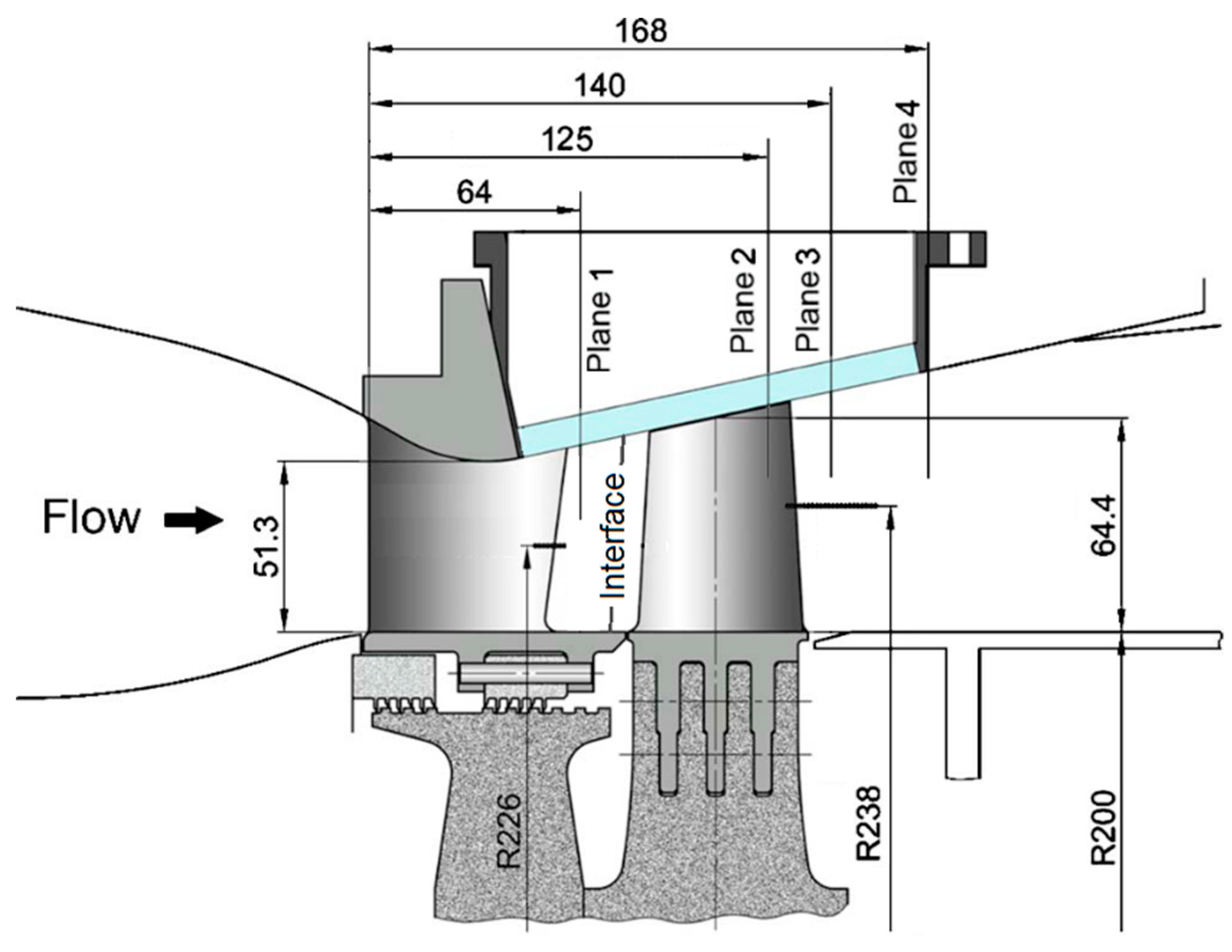
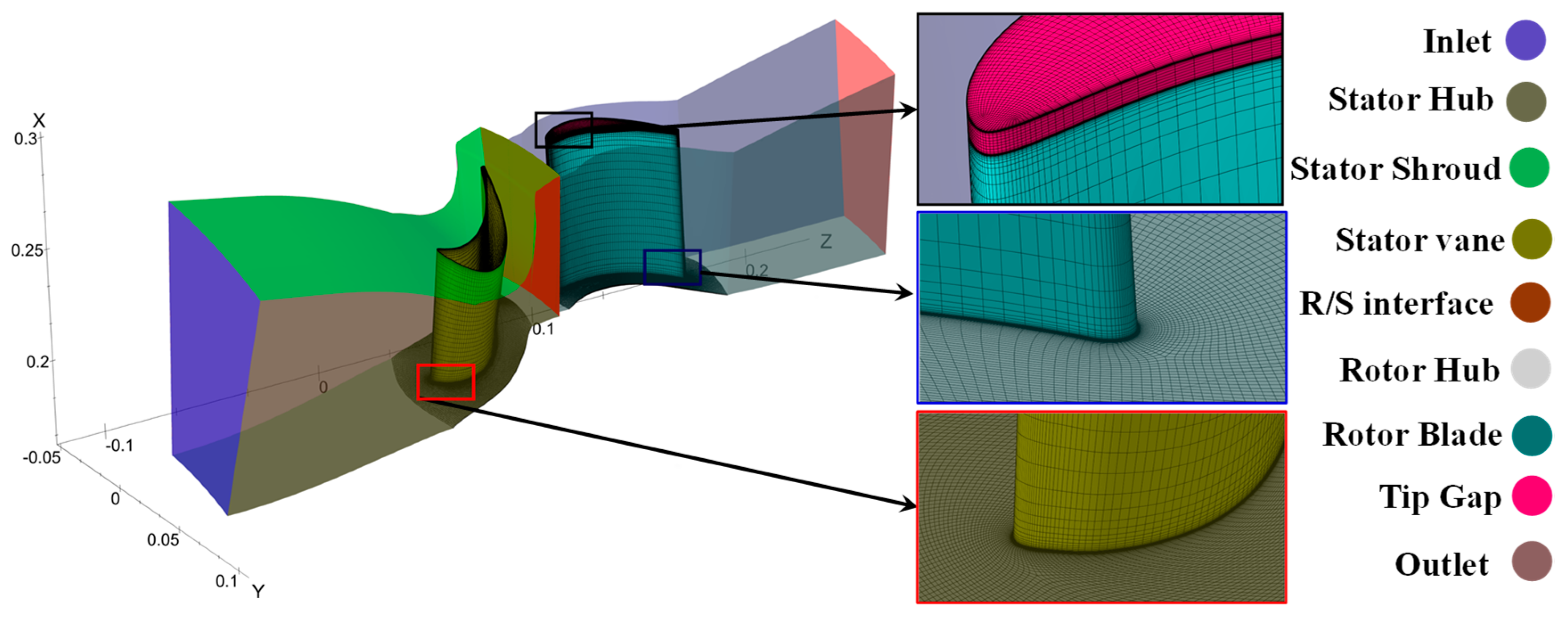
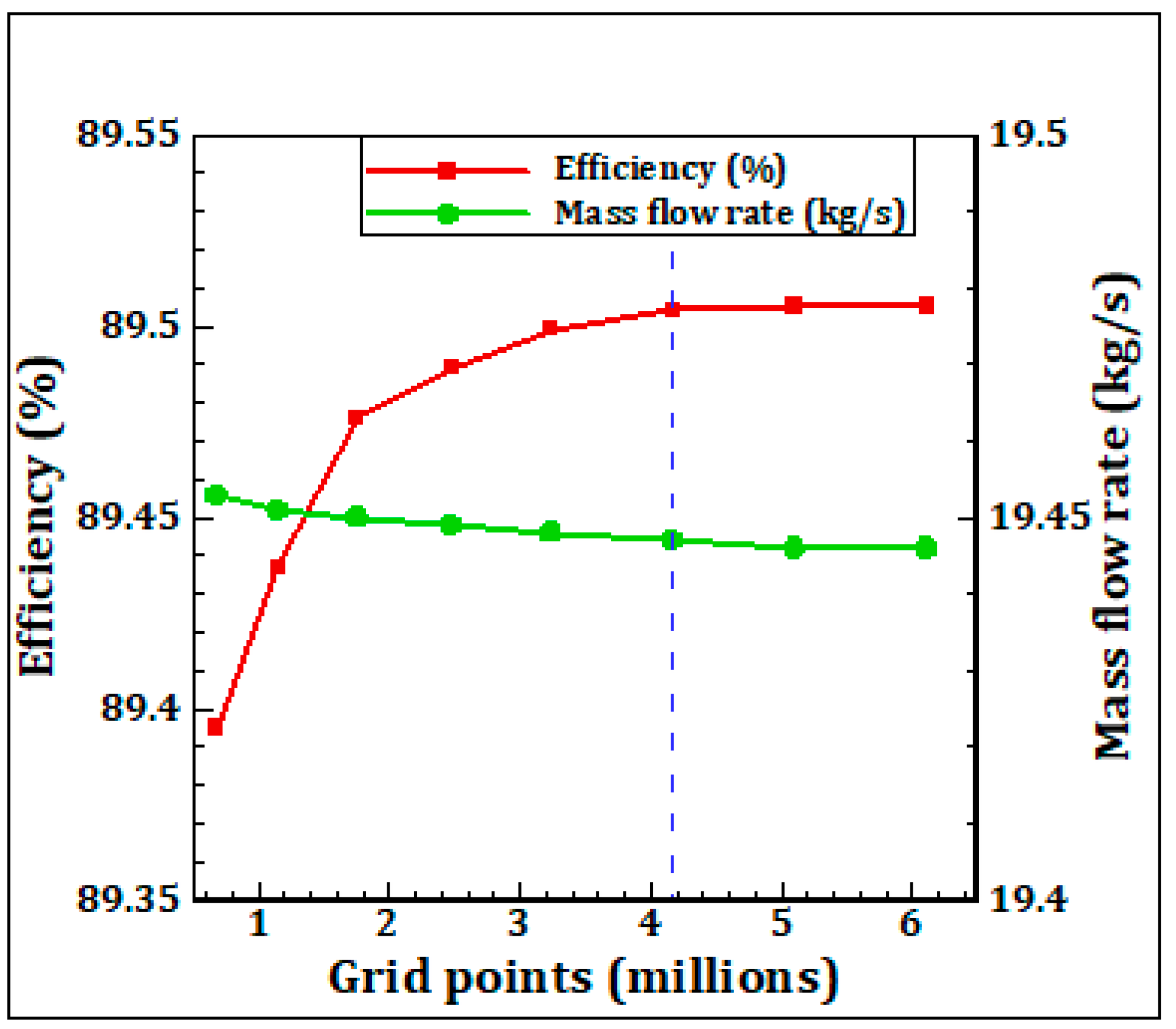
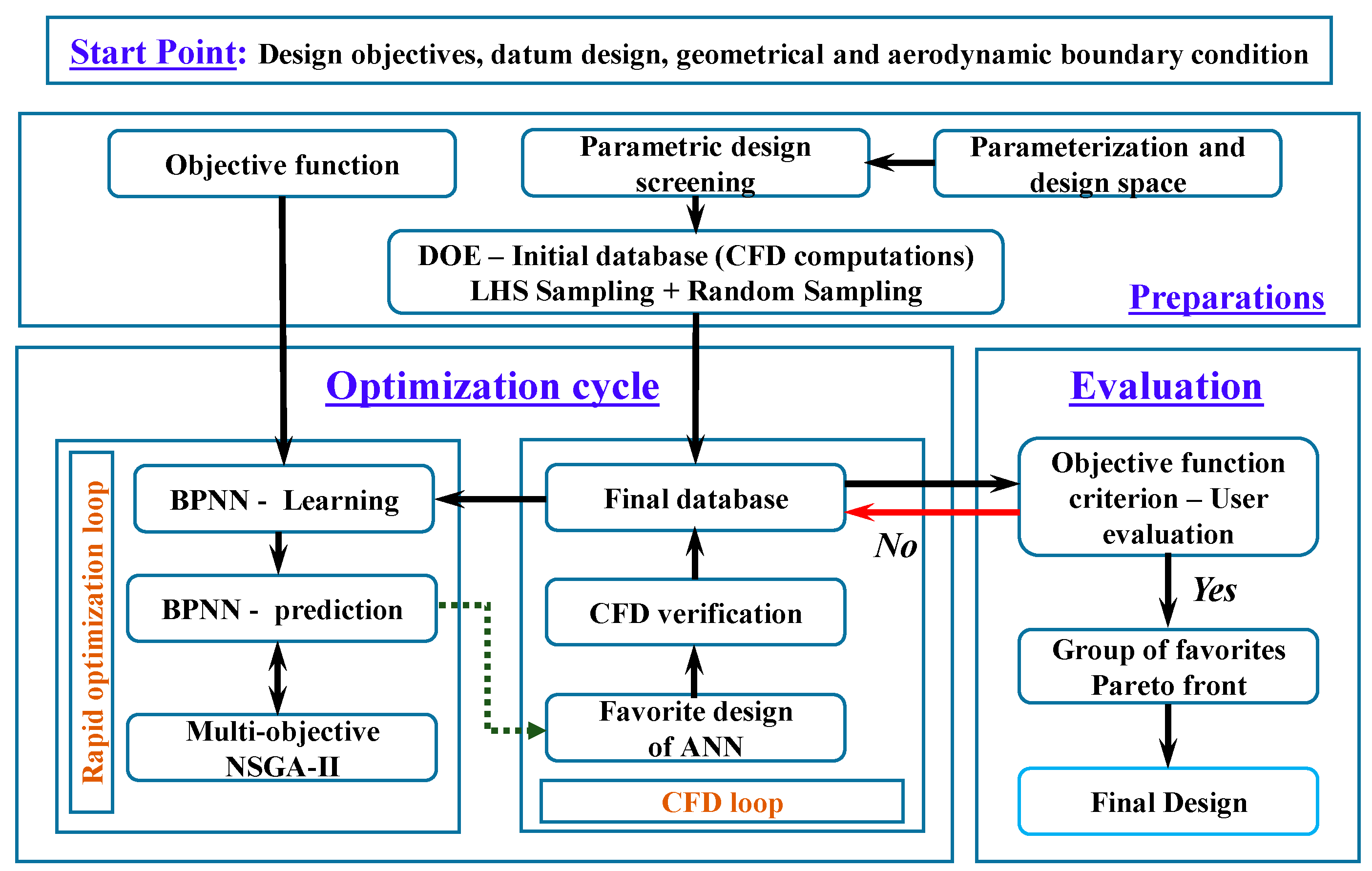

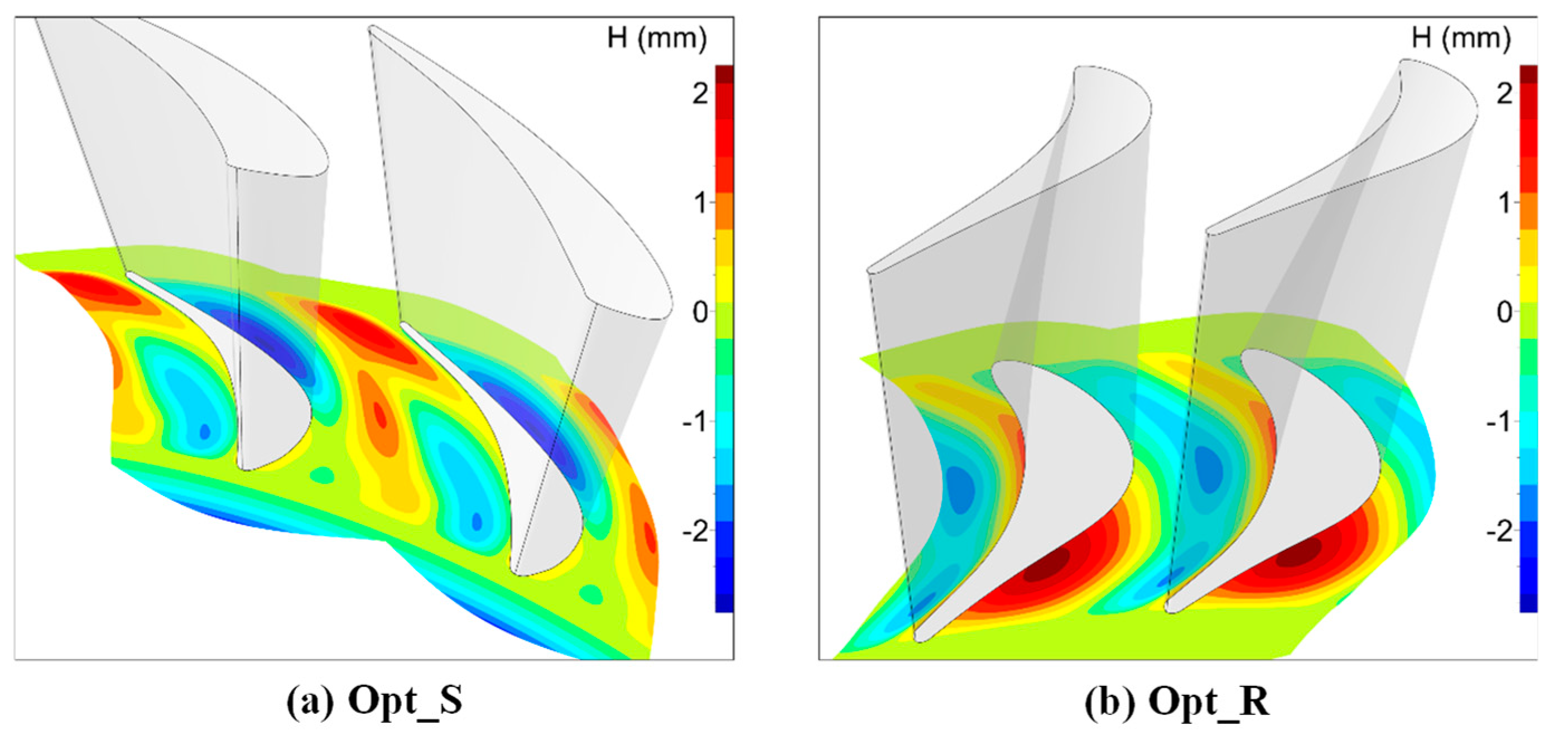

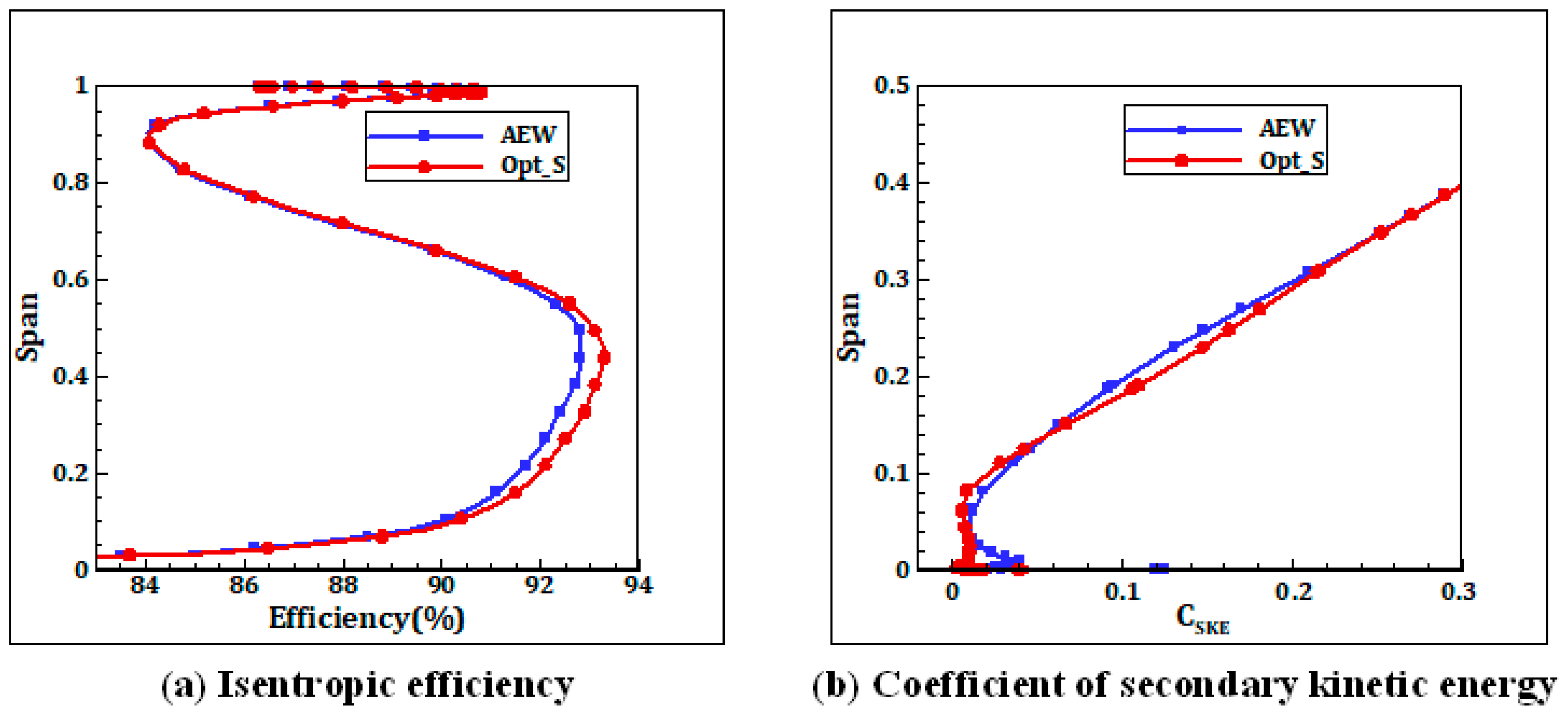



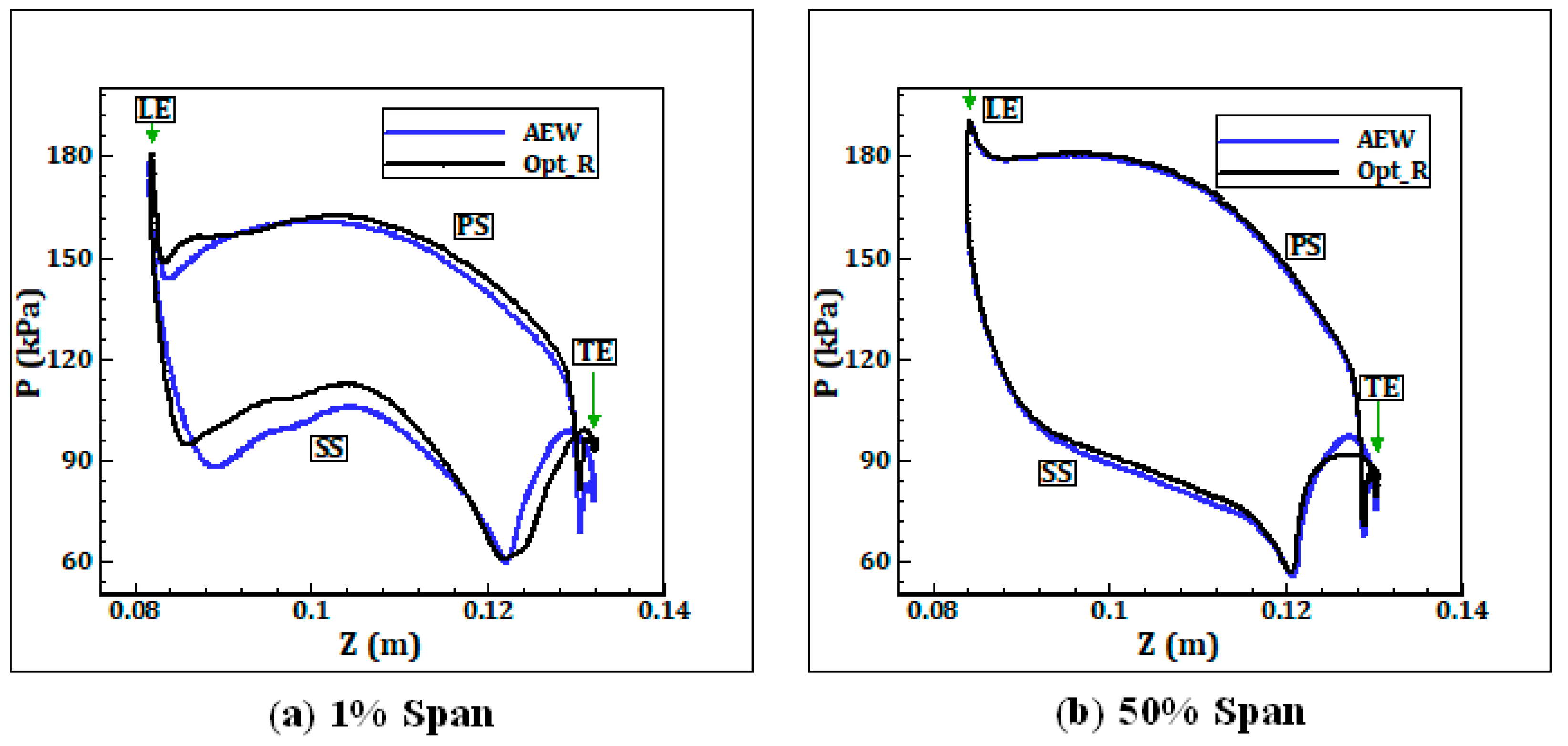

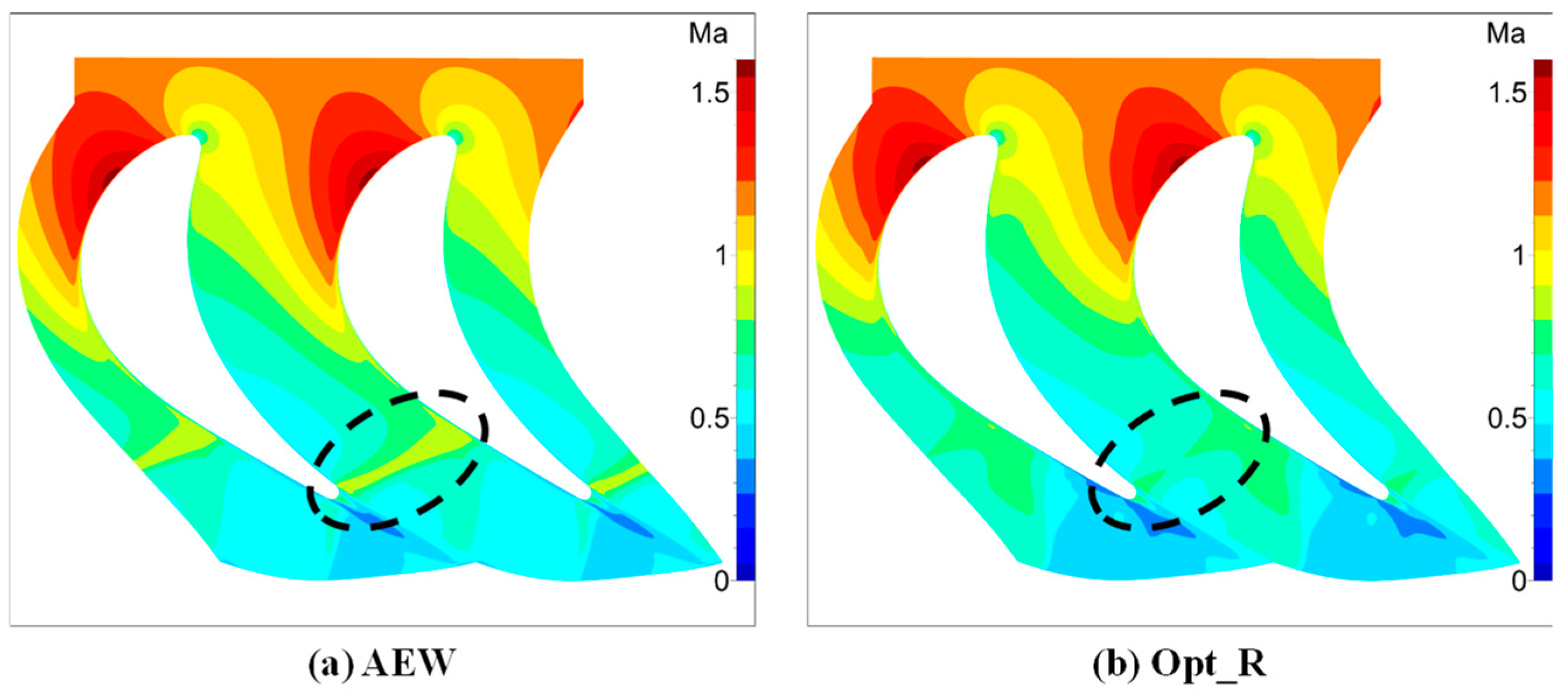
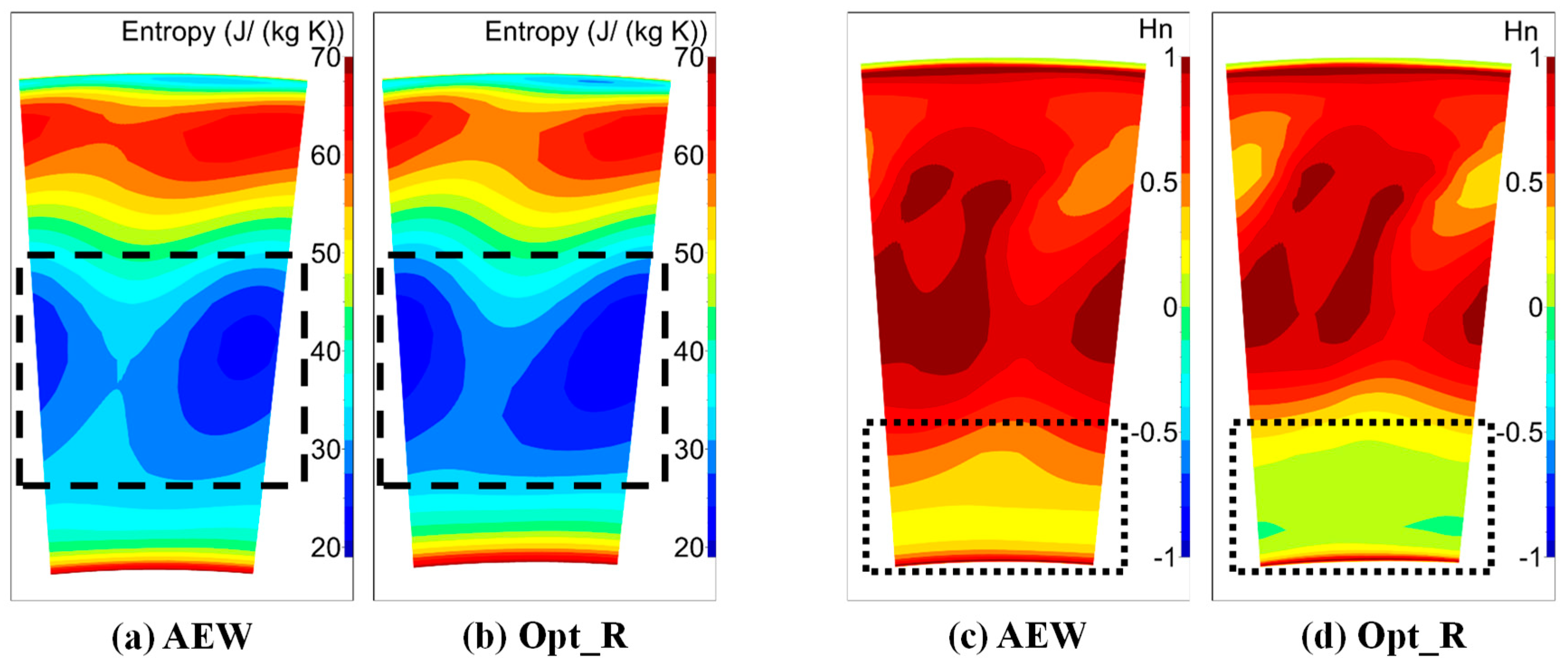


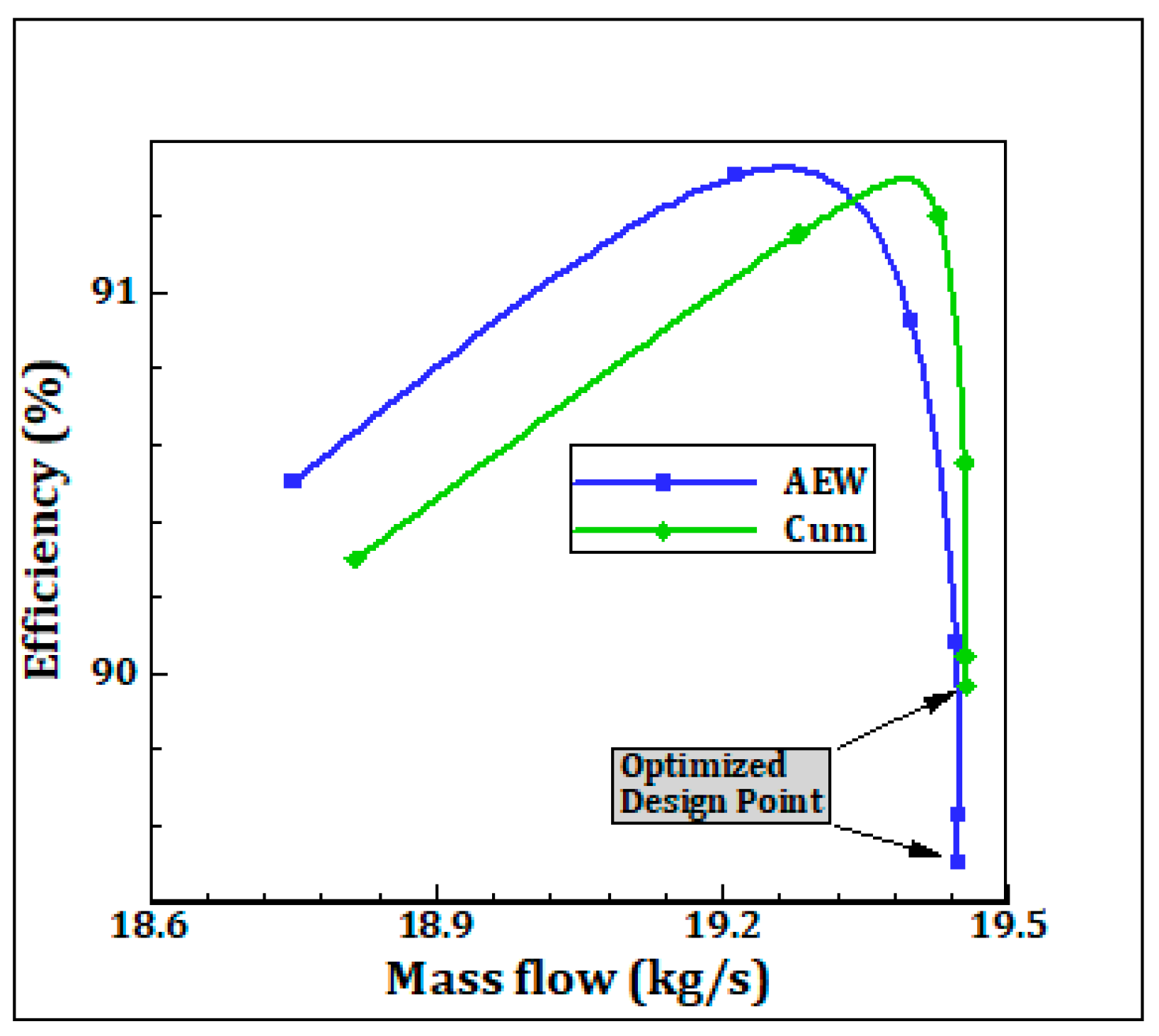



| AEW | 89.504 | 19.447 | 0.061 | 0.3 | |
| Opt_S | Value | 89.746 | 19.455 | 0.058 | ___ |
| Change | +0.27% | +0.04% | −4.92% | ||
| Opt_R | Value | 89.727 | 19.447 | ___ | 0.3005 |
| Change | +0.25% | 0% | +0.17% |
© 2019 by the authors. Licensee MDPI, Basel, Switzerland. This article is an open access article distributed under the terms and conditions of the Creative Commons Attribution (CC BY) license (http://creativecommons.org/licenses/by/4.0/).
Share and Cite
Rehman, A.; Liu, B.; Asghar, M.A. Secondary Flow and Endwall Optimization of a Transonic Turbine. Energies 2019, 12, 4103. https://doi.org/10.3390/en12214103
Rehman A, Liu B, Asghar MA. Secondary Flow and Endwall Optimization of a Transonic Turbine. Energies. 2019; 12(21):4103. https://doi.org/10.3390/en12214103
Chicago/Turabian StyleRehman, Abdul, Bo Liu, and Muhammad Afzaal Asghar. 2019. "Secondary Flow and Endwall Optimization of a Transonic Turbine" Energies 12, no. 21: 4103. https://doi.org/10.3390/en12214103





